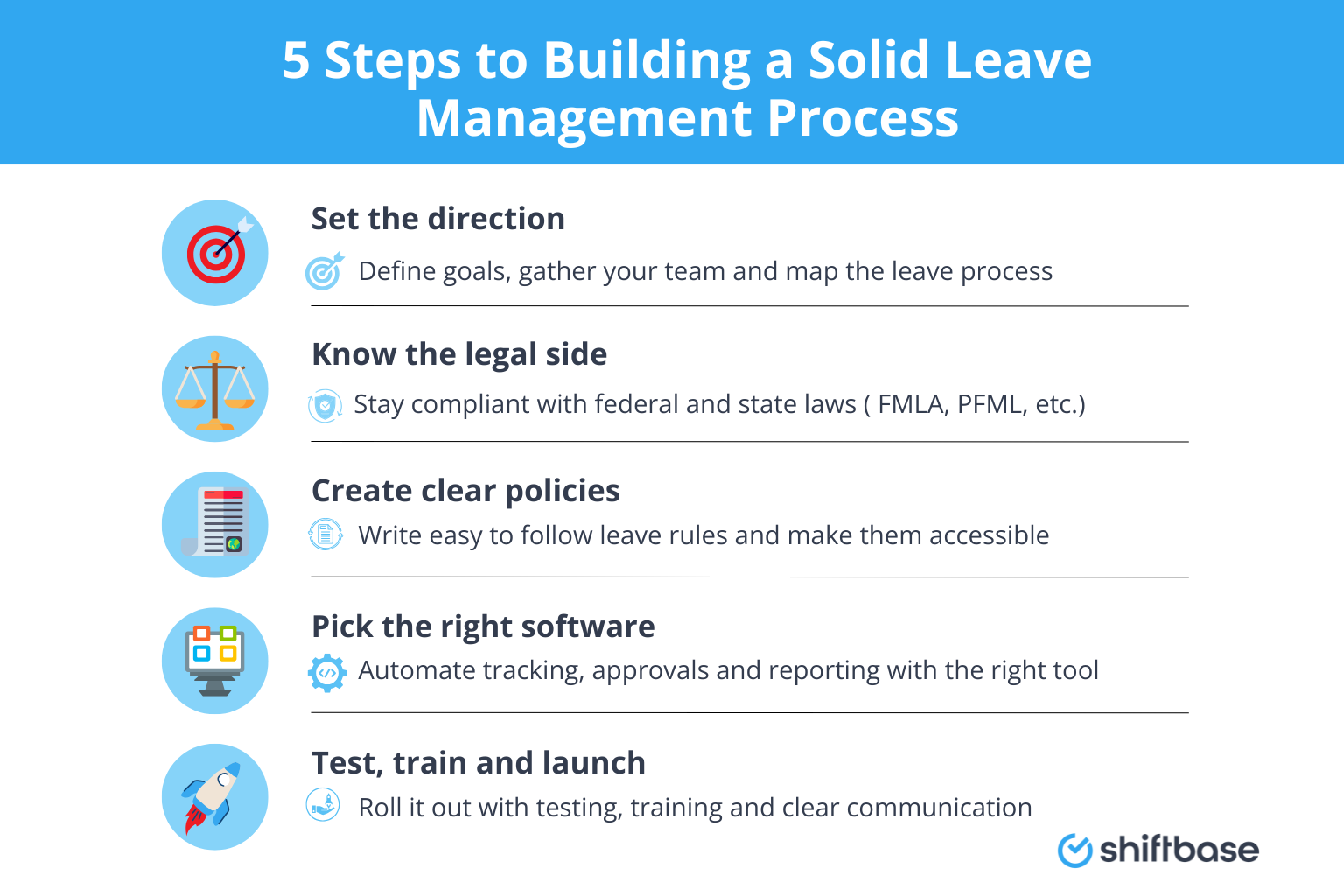In this article, we look at the various facets of leave management, explore its types, and understand how its effective implementation aligns with legal compliance and boosts the holistic health of both employees and the organization.
What is leave management?
Leave management is all about staying on top of who’s taking time off, when, and why — without letting it mess up your operations. Think of it as the system (or process) that helps you approve, track, and record employee leave in an organised way. That includes everything from annual holidays and sick leave, to parental leave and jury duty.
Leave management VS Absence management
Now, don’t confuse this with absence management — they’re cousins, not twins.
Here’s a quick side-by-side to make it crystal clear:
| Feature |
Leave Management |
Absence Management |
| Focus |
Planned time off (e.g. holidays, parental leave) |
Unplanned or frequent absences (e.g. sick days, no-shows) |
| Goal |
Track and manage entitlements and approvals |
Reduce absenteeism and its impact |
| Examples of leave |
Vacation, sick leave, bereavement, unpaid leave |
Frequent sick days, late arrivals, unexplained absences |
| Tools involved |
Leave request systems, calendars, HR platforms |
Attendance tracking, HR analytics, manager interventions |
In simple terms, leave management is proactive and planned while absence management reactive and unplanned.
Both matter if you want to keep your business running smoothly, but leave management is where it all starts — it gives your team structure, fairness, and clarity about time off.
Benefits and challenges of leave management
A well-oiled leave management system doesn’t just save headaches — it’s a game-changer for keeping your team happy and your business running like clockwork. That said, it’s not without its hiccups. Let’s break it down:
✅ The benefits of leave management
| Benefit |
Why it matters for employers and managers |
| Better planning & staffing |
You avoid under- or overstaffing by knowing exactly who’s off and when. |
| Happier employees |
When people feel their leave is handled fairly and smoothly, morale (and loyalty) goes up. |
| Legal compliance |
Keeps you on the right side of labour laws and avoids nasty penalties or disputes. |
| Time-saving automation |
Leave software cuts out the endless back-and-forth of emails and spreadsheets. |
| Fewer payroll errors |
Accurate tracking means you don’t overpay or underpay people on leave. |
| Data for smarter decisions |
Trends in leave usage can help you spot burnout risks or adjust policies. |
⚠️The challenges of leave management
| Challenge |
Why it’s a pain — and how to tackle it |
| Manual processes are messy |
Paper forms and spreadsheets are error-prone and time-consuming. Time to go digital. |
| Policy confusion |
Vague or outdated leave policies lead to misunderstandings and pushback. |
| Last-minute leave requests |
These can disrupt schedules, especially in smaller teams. A clear request process helps. |
| Tracking different leave types |
Annual leave, sick leave, parental leave… it’s easy to lose track without a proper system. |
| Legal complexity |
Leave laws vary by state (and change often), so staying compliant takes ongoing effort. |
| Team resentment |
If leave isn't managed fairly, it creates tension between those covering for others. |
Getting leave management right isn’t just about keeping a tidy calendar — it’s about building a workplace where people feel supported, policies are clear, and chaos doesn’t break loose every time someone takes a holiday.
Yes, it takes a bit of structure and the right tools, but the payoff is worth it: fewer rota headaches, happier staff, and less time spent firefighting last-minute absences.
Once you get the system working for you (not the other way around), it becomes one of those invisible heroes of smooth business operations.
Legal requirements of leave management
Managing employee leave is also about staying compliant with state and federal laws. And trust us, skipping the fine print can land you in real trouble (hello, lawsuits and fines). So here’s what you need to know.
Federal laws every employer should know
| Law |
What it covers |
Who it applies to |
| FMLA (Family and Medical Leave Act) |
Up to 12 weeks of unpaid, job-protected leave for family or medical reasons |
Employers with 50+ employees |
| ADA (Americans with Disabilities Act) |
Requires reasonable leave accommodations for employees with disabilities |
Employers with 15+ employees |
| USERRA (Uniformed Services Employment and Reemployment Rights Act) |
Leave for military service, with job protection |
All employers, regardless of size |
| Pregnancy Discrimination Act |
Time off related to pregnancy must be treated like any other medical leave |
All employers covered under Title VII |
🧠 Pro tip: “Unpaid” doesn’t mean unimportant. Even if the leave isn’t paid, the job protection and compliance side still applies.
⚠️Watch out: state and local leave laws are catching up fast
States are rolling out their own leave policies — and many go further than federal law. Here are just a few recent examples:
| State |
Leave update (2024–2025) |
| Connecticut |
Paid sick leave expanded to more employers (25+ workers) — 1 hour per 30 hours worked |
| New York |
20 hours of paid prenatal leave added (on top of existing sick leave) |
| California, Washington, Oregon |
Robust Paid Family and Medical Leave (PFML) programs are live |
| Delaware, Maine, Maryland, Minnesota |
PFML benefits set to roll out in 2026 — planning ahead is smart |
🔍 What this means for you: Your business might be subject to different rules depending on your state, industry, and size — so one-size-fits-all policies won’t cut it.
Key responsibilities for employers
To stay compliant and keep things running smoothly, here’s what you must do as an employer:
- Have a clear leave policy in writing and make it easily accessible to all employees
- Track leave balances and usage accurately — manually or using software
- Handle requests consistently and fairly (don’t play favourites)
- Keep records of all leave requests, approvals, and communications
- Stay up to date with federal, state, and local leave laws — they change often!
The 5 steps to building a solid leave management process
Whether you're setting up leave management from scratch or upgrading from sticky notes and spreadsheets, these five steps will help you create a system that works — for your team and your business.
1. Set the direction: what does good leave management look like for you?
Before diving into tools and templates, get clear on what you’re actually trying to fix or build. Are you tired of chasing approvals? Struggling with rota chaos every school holiday? Start with the why, then move on to the how.
👉 Do this:
- Gather a small group of decision-makers — think HR, ops, managers, and legal if needed
- Set goals: e.g. reduce approval time, improve transparency, avoid scheduling clashes
- Draft a simple project plan with responsibilities, timelines, and key milestones
- Decide what kind of leave your policy will cover (holidays, sick leave, parental leave, etc.)
🛠 Tip: A quick whiteboard session or shared doc in Notion or Google Drive works wonders here.
2. Know the legal side (yes, it matters)
Here’s where it gets real. Leave laws in the U.S. are a bit of a patchwork — some rules are federal, others vary by state. And they change often. So before finalising your process, make sure you’re not setting yourself up for compliance trouble.
👉 What you should do:
- Identify which leave laws apply to your business (FMLA, state PFML, etc.)
- Check if you’re required to offer paid sick leave, and how it accrues
- Bring in legal counsel (internal or external) if you’re unsure — it’s worth the peace of mind
- Set a calendar reminder to review legal updates regularly (quarterly works well)
3. Create clear and fair leave policies
This bit is your rulebook. Clear policies protect your business and give employees confidence in how leave is handled. And no — “we’ll see what we can do” isn’t a policy.
👉 Write policies that define:
- Types of leave offered
- How to request time off
- How much notice is needed
- What happens if someone’s request is denied
- How time off is tracked and approved
Run your policy past managers and legal to make sure it’s workable and compliant. Put it somewhere easy to find — intranet, HR portal, or shared drive
🔁 Pro tip: Review your policy yearly. If it’s gathering dust, it’s probably outdated.
4. Choose the right leave management software (and make it work for you)
Manual tracking = mistakes, delays, and pain. A good leave management system (LMS) automates the boring bits, reduces errors, and makes things way easier to scale.
Make a shortlist of LMS tools that fit your needs (e.g. Shiftbase 😉)
🔎 Look for features like:
- Self-service leave requests
- Manager approval workflows
- Real-time leave balance tracking
- Calendar sync and conflict alerts
- Custom reporting
Set up demos, ask lots of questions, and involve the teams who’ll use it. Factor in support, integrations, and pricing — not just the shiny interface
5. Test it, train your team, and go live with confidence
The best system in the world will fall flat if people don’t know how to use it. Testing and training aren’t just box-ticking — they make sure your rollout isn’t a flop.
👉 Do this:
- Set a clear go-live date and work backwards from there
- Test the system with a small group — try out real leave requests, approvals, edge cases
- Develop a short training session or user guide (bonus points for a quick video)
- Make it easy for employees to ask questions and give feedback during the first few weeks
📣 Don’t forget to communicate the “why” — show your team how this change benefits them, not just HR.

Conclusion
Leave management doesn’t have to be complicated, but it does have to be consistent, compliant, and easy for everyone to follow. Start with the foundations, choose the right tools, and communicate clearly — you’ll save time, reduce stress, and create a fairer workplace in the process.
Mastering Leave Management with Shiftbase
Effective leave management is more than just recording when employees take days off—it's about ensuring business continuity, boosting morale, and maintaining legal compliance.
This intricate balancing act requires precision, foresight, and the right tools. Shiftbase, a state-of-the-art workforce management SaaS, is designed to simplify this very process.
With features ranging from employee scheduling to time tracking, it shines exceptionally in absence management. Dive into comprehensive leave management tools, get instant notifications, and generate insightful reports to ensure you're always ahead of the curve.
Ready to revolutionize your approach to leave management? Try Shiftbase for free for 14 days and see the difference yourself.

Manage leave and absence with ease!




